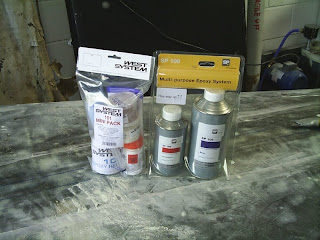
Maybe it's just geography - after all, we are in a large flat area of the UK that get's a lot of sunshine and very little rain fall, and in the Spring and Autumn gets some proper electrical storms - but sometimes workshop legends become true.
When we first set about rebuilding my old Firefly, (F888 Desperado) in 2001/2- arguably the first big rebuild we ever did, the workshop I used at the time - just 8 miles from London Stanstead Airport, was right in the warpath of some of the biggest storms I can remember. Work on the boat was often hampered by the works flooding - and in one particular storm , lightning hit the local power sub station and knocked out the whole industrial estate instantly - fine except it was 1am and me and the boat were pitched into total darkness! Jokingly I told my friends Desperado had been born in a storm...
The next boat we stripped and rebuilt was in 2005 - a 14 footer (GBR 1434) - Black Dog II. This was a special boat - my first proper skiff, and although she was 5 years old when we got her, she was the first of the Morrison 10's built - and all carbon throughout. Brilliantly built by RMW in the prime of their time - although that didn't stop me ripping up the deck and moving the centreboard (to very good effect I might add) A weapon and a half that boat... (it smashed my teeth in teaching me to bear away when you are fully pressed) Halfway through the rebuild and while working a late one the rain started to fall on the roof so hard you couldn't hear yourself think. An electric storm to stand the hairs on the back of your neck ensued and I remember metal bin lids flying around outside like eery flying saucers against the rain in the sodium street lamps. Man that was a storm. Great boat too.
Next came the GT60/ B1c Cherub (Ronin - GBR 2698) which we took to the Hyeres ISAF trial.. blah blah...! We built the whole thing here in Woodbridge in 2007 (man was it really 2 years ago Princey!!) in just 5 weeks from making the plug to the test sail. About a week from painting and we were using a laser to true up the centreboard case and mast foot. It had been a hot spring day and a light rain was just starting when I stopped for a cuppa as evening fell. A couple of hours later and I hadn't heard the monsoon outside, when BANG! All the lights went down and I thought I had gone deaf. The lightning had hit the ground less than 50m from the front door of the shop - which for once was closed. It sounded like a bomb going off. Ronin, with Pete Barton and Roz Allen on board won the first 11 races out of 12 at the 2009 nationals (they didn't sail the last race)
2008 and we're building moths. Specifically Velociraptor 'S' types of which there were only ever 2 - my boat (Voodoo - GBR 3372) and Adams boat (Envy - GBR 3373) for the 08 Worlds in Weymouth (Weymoth!). Both boats were in the shop in full on build mode, we were jigging in Adams foredeck and the glue was going off on the working deck join on mine. It was properly late - in fact we were on our way to working through to daylight, which when boats are being built isn't uncommon around here! The wind started to get up and I could hear the rain against the back window. We opened the front shutter door and turned out the workshop lights - It wasn't raining that hard and n fact there was a light fog, but the storm was above it. The sky flashed purple and then blue, then completely white - for so long at a time, you would have sworn it was 10am. 'Massive electric storm disrupts power supplies' was the headline in the next days 'Evening Star'. Adam got some pictures of his boat in build without a flash on his camera. Great boats... Rapid.. Adam won Kiel week about 2 weeks later.
A week ago and I'm finishing off the engineering in the foredeck of GBR52. Its late, but I'm nearly done. I heard a noise like next door are moving furniture, or maybe shutting their main doors. Not unusual I think to myself - except Mike from next door put his head around the corner to say he was going home maybe 6 hours ago. I open the main doors to get some air. Instantly there's a flash and a bang and I jump out of my skin. There's no rain - then I can hear it coming up the road - like a road cleaning truck but louder! The street lamps start to swirl in the torrent and simaltaniously... Flash - BANG - FLASH FLASH........................ Awesome awesome Spring storm. I turned off the computers (twice bitten!), made myself a coffee, and took 5 minutes to look out at the rain. I'm sitting on the tail of the skiff. Another one born in a storm.



 Here's the whole stack. Working from the foam upwards - Reinforcements: 86g E-glass Woven, 200g Carbon Woven. Consumables: Peel Ply, Porous Release Film, Breather Fabric, Vacuum Bag Film. If you want to get hold of handy amounts of vac bagging materials have a look
Here's the whole stack. Working from the foam upwards - Reinforcements: 86g E-glass Woven, 200g Carbon Woven. Consumables: Peel Ply, Porous Release Film, Breather Fabric, Vacuum Bag Film. If you want to get hold of handy amounts of vac bagging materials have a look 








